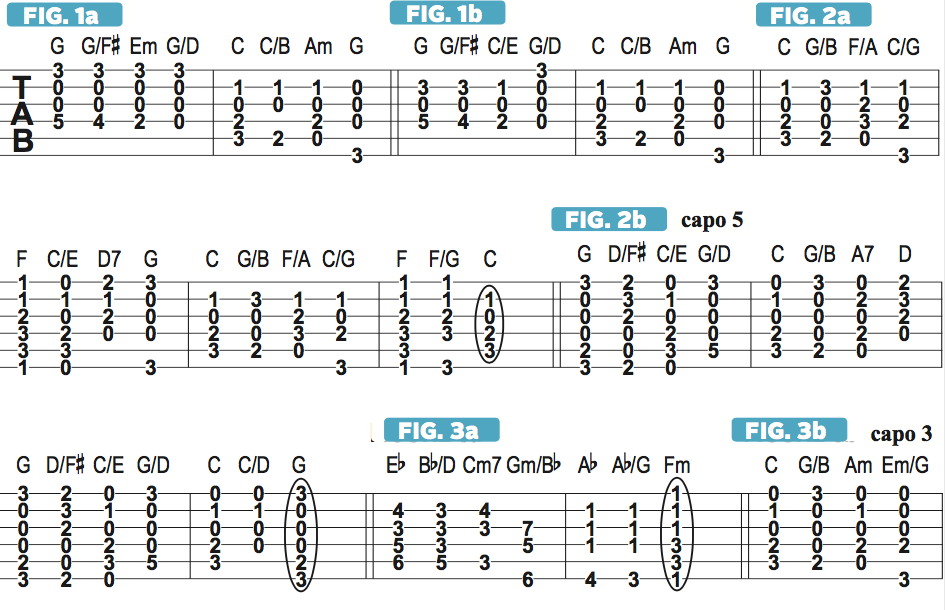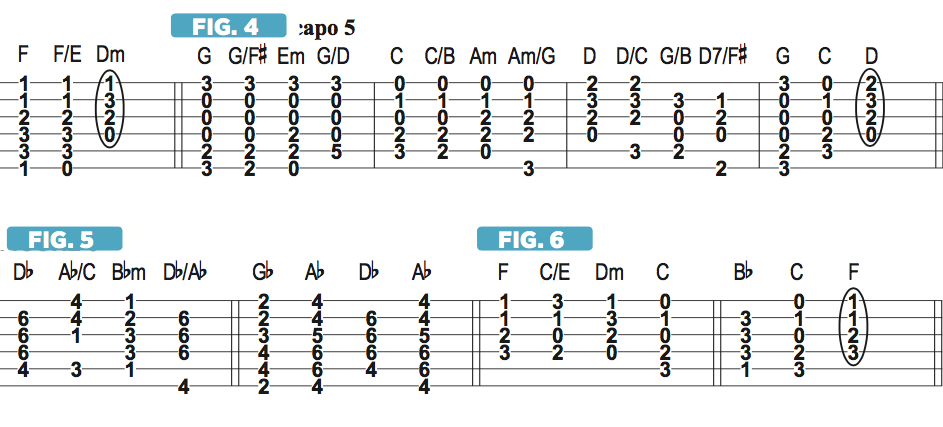Songwriting Tips—Pairing Chords with Walking-Down Bass Lines
There’s something inherently appealing about a chord progression built around a bass line that “walks down” the major scale. In the previous lesson, I cited the bridge sections to the Beatles’ “Hey Jude” and John Lennon’s “Imagine” as classic examples of pop songs that feature this kind of motion while two or more chord tones remain constant, as common tones, above the descending bass notes. I’d now like to pursue this topic further and examine passages from other famous songs that include similar bass drops and are additionally paired with chord inversions, for which a non-root chord tone, such as the third or fifth, is the lowest note, or “in the bass.”
The intro and verse progression to the Grateful Dead’s “Friend of the Devil” is a prime example of what I’m talking about here and is built around a descending G major scale (G A B C D E F#), played on acoustic guitar in a sort of “pick-y, strum-y” bluegrass flatpicking style, using the fretboard shapes illustrated in FIGURES 1a and 1b, which represent composites of Jerry Garcia’s and Bob Weir’s sparsely interwoven, overlapping parts. Notice the convenient employment of the open G and B strings here, or the fretted D, all of which live within the G major scale, and how certain bass notes become the third, fifth or seventh of the chord. The term first inversion means the third, which may be either major or minor, is the lowest note—for example, G/B (“G over B,” which signifies a G chord over an B bass note). Second inversion means the fifth is in the bass—for example, G/D (“G over D”)—and third inversion, which is less common, means the seventh is on the bottom—for example, G/F#, which technically is Gmaj7/F#.
The progression Billy Joel impeccably crafted for the intro, verse and chorus sections of “Piano Man” is built around a bass line that walks down the C major scale (C D E F G A B) and features an elegant, classical-like sequence of major chords that are either in root position (with the root in the bass) or first or second inversion. FIGURES 2a and 2b illustrate two sets of voicings and fingerings that convey this progression nicely on guitar, the second one performed with a capo at the fifth fret, as if we were in the key of G, which is how I like to play these changes, using these higher voicings. Another appealing thing about this progression is the inclusion of a secondary dominant chord, specifically the D7 that resolves to G (or, in the capo-5 version, the A7 that resolves to D). This is what’s known as the five-dominant of the five chord, or the “five of five,” for short.

Other classic examples of sections of songs that include a chord progression built around a descending-major-scale bass line are the intro and verse to “Forever” by the Beach Boys (key of Eb), the verse and chorus to “A Whiter Shade of Pale” by Procol Harum (key of C), the verse to “When a Man Loves a Woman,” popularized by Percy Sledge (key of Db), and the intro to Elton John’s “Goodbye Yellow Brick Road” (key of F). FIGURES 3a through 6 offer sets of voicings that outline the major-scale-bass-drop progressions heard in these enduringly appealing songs, with some convenient capo options included.

All the latest guitar news, interviews, lessons, reviews, deals and more, direct to your inbox!
Over the past 30 years, Jimmy Brown has built a reputation as one of the world's finest music educators, through his work as a transcriber and Senior Music Editor for Guitar World magazine and Lessons Editor for its sister publication, Guitar Player. In addition to these roles, Jimmy is also a busy working musician, performing regularly in the greater New York City area. Jimmy earned a Bachelor of Music degree in Jazz Studies and Performance and Music Management from William Paterson University in 1989. He is also an experienced private guitar teacher and an accomplished writer.

